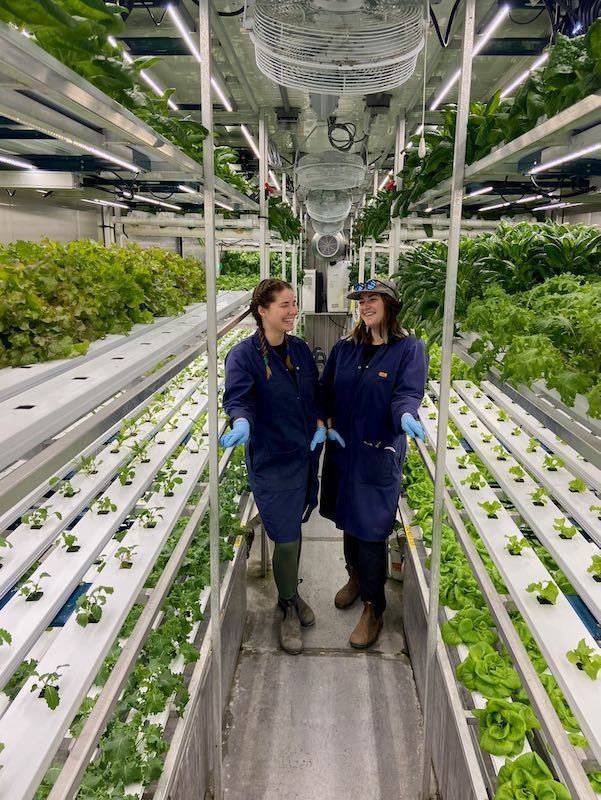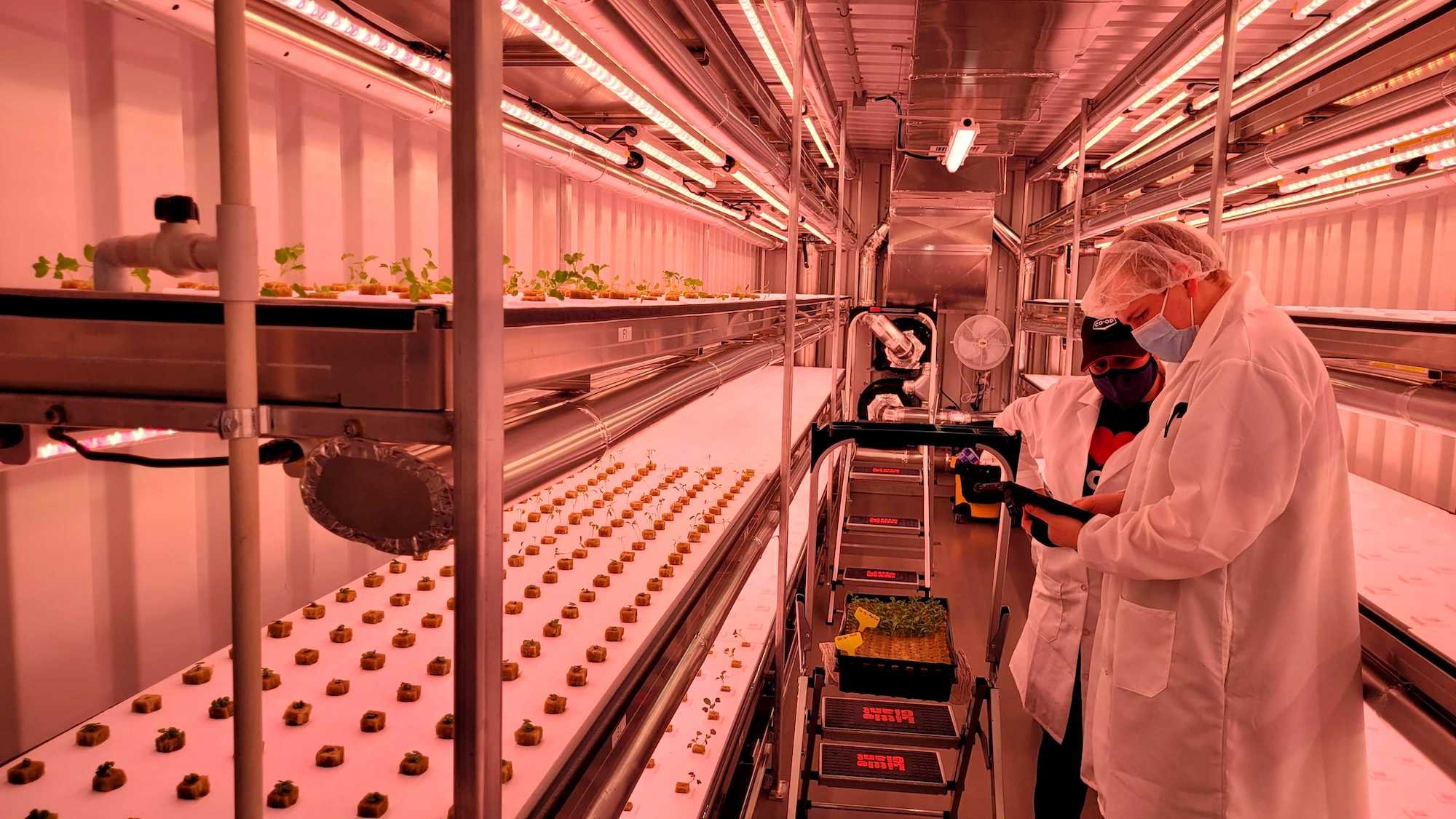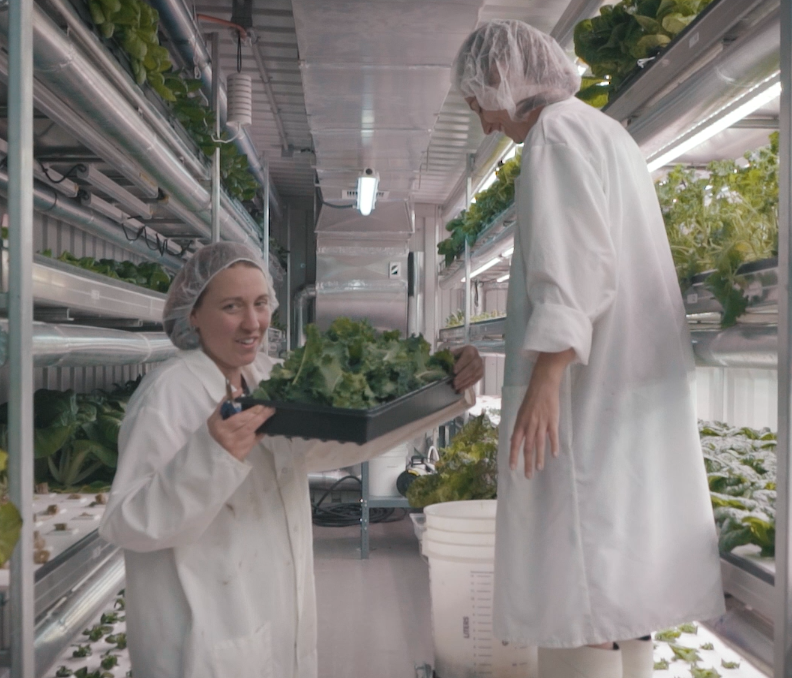Comparing hydroponic setups: DWC vs. NFT
The type of hydroponic growing system matters most when you’re comparing different types of vertical farms.
There’s many types of hydroponic farming systems like nutrient film technique (NFT), deep water culture (DWC) and ebb and flow. All these systems deliver nutrient-rich water to the plants in different ways.
By the end of this blog, you’ll better understand the different types of systems and their advantages and disadvantages for you as an operator.
But first, a caveat, no system is perfect. What one operator finds easy, another might find difficult. You will always have to tweak your system so it works best for you.
Don’t want to wait? Grab the entire vertical farm comparison series as a PDF here.
SUMMARY
Deep water culture (DWC): plants sit on floating rafts under lights with their roots in nutrient solution.
Nutrient film technique (NFT): plants sit in gutters with a shallow nutrient solution that flows by plant roots.
A DWC system offers more reliability and temperature stability because roots are always submerged in water.
However, maintenance for a DWC and NFT system looks different. Cleaning in a DWC system is easier but you have to do it more often.
Because you have more water and more nutrients in a DWC system, you’ll have to worry about your waste water management more.
Disease and yield are fairly equal across systems and good maintenance makes a bigger difference on how much yield you can extract from your hydroponic set up.
DWC is the most forgiving system for new growers and considered the most accessible technology when compared to NFT and ebb and flow systems.

A DWC system offers more reliability and temperature stability because roots are always submerged in water.

Fun fact: Growcer’s first farms were NFT systems but we’ve since switched to DWC because it’s more reliable and forgiving for new growers.
What is Deep Water Culture (DWC)?
In a deep water culture (DWC) system, plants sit on floating rafts under lights with their roots in nutrient solution.
A DWC system can be passive (run to waste) or active (recirculating). Growcer’s Osiris farm is an active system where nutrient solution is recirculated throughout. This is a more sustainable approach instead of wasting perfectly fine nutrient solution, but requires more cleaning and filtering from the operator.
What is Nutrient Film Technique (NFT)?
In a nutrient film technique (NFT) system, plants sit in gutters with a shallow nutrient solution that flows by plant roots.
An easy way to picture the difference between DWC and NFT is to imagine plants sitting in a lake (DWC) or a river (NFT).
Fun fact: When Growcer first started we built a NFT system. In early 2020, we switched to a DWC system because we found deep water culture was more forgiving for new growers and this aligned with our mission to make farming year-round accessible to all. When it comes to accessibility and ease of use, DWC wins the battle.
Benefits of Deep Water Culture Hydroponics vs. NFT
Reliability
What happens if you lose power? Will your plants survive?
In a DWC system, roots are always sitting in nutrient solution. So even if the power goes out, your system will be stable for a few days because the plants still have access to their food.
In a NFT system, because roots are in a film of nutrient solution that is pumped under the plants, as soon as the pumps go out (or get clogged), you could lose all your plants.
This is of course dependent on the plant load and age at the time - hydroponics is not a zero-sum game. You can still revive your plants in a NFT system if you get the power back on within a reasonable timeframe. Plants are more resilient than we think.
Ultimately, the reliability of your hydroponic system determines how frequently you can harvest and pay off your investment. If you’re losing harvests left, right and center, your ROI will extend beyond what you anticipated.
Temperature and nutrient stability
Plant processes such as photosynthesis (creating food/energy), transpiration (water loss), respiration (breathing), seed germination and flowering (bolting) are all influenced by temperature.
By controlling temperature, indoor plants can outperform their outdoor counterparts and grow bigger, faster.
A DWC system has better temperature stability and the water’s temperature stays closer to what roots need. The bigger body of water is not affected by ambient temperatures as much as a smaller body of water, like with a NFT set up.
In a NFT set up, the shallow nutrient film has low volume and high surface area so it will heat up quickly to ambient temperatures.
You would also have to consider the potential of an uneven distribution of nutrients along the troughs. Because it is a thin layer of nutrients, nutrients can get depleted along the gutter, especially if older, hungrier plants are present.
“Because it is a thin layer of nutrients, nutrients can get depleted along the gutter, especially if older, hungrier plants are present. ”
And when plants at the end of your troughs don’t get enough nutrients, they don’t grow as fast or as big so you’re left with uneven plant sizes within your farm. This is not a problem if you enjoy explaining to customers why your product is so variable from week to week.
Water is a good buffer for plant health and the more water you can have per plant the better.

Comparing NFT vs. DWC on a variety of factors shows that DWC setups rank high for water volume, system stability and productivity.
Cleaning
A NFT system has more parts, and therefore, more parts to clean.
Rafts within a DWC system are easier to clean but only if you consider having bigger, heavier parts easier than many smaller, lighter parts.
A DWC system is heavier in overall weight because the racks need to be able to hold more water volume (and a heavier system also means higher capital costs).
Water borne diseases
Speaking of water, water borne diseases are no stranger to hydroponic farming. It’s why regular maintenance is essential for good yields.
In a DWC system, where you have standing water, you have a bigger breeding ground for algae, pythium, and other water borne pathogens. Because you have more water and more nutrients, you’ll also have to worry about your waste water management more.
Note: Algae is common in all hydroponic systems and is relatively harmless when good maintenance is maintained.
However, in a NFT system, because you have shallow water and less water in general, you reduce the probability of water borne diseases. But less water doesn’t mean no diseases - disease and yield potential across NFT and DWC systems are more equal than you think. And if you’re not on top of your maintenance, it won’t matter that you have less water.
“And if you’re not on top of your maintenance, it won’t matter that you have less water.”
That’s why it’s important for you as an operator to consider, how do I want to spend my time growing?

Water is a good buffer for plant health and the more water you can have per plant the better.
Oxygen
Oxygenation is better in a DWC system. In a Growcer farm, air stones sit in water reservoirs to ensure the nutrient solution is saturated with oxygen.
In a NFT system, because there is a lot of air in the gutters naturally, oxygen is not a limiting factor.
In a DWC system, your roots are suspended in a big volume of nutrient solution that needs to be saturated with oxygen. This helps water stay closer to what the roots need (and ultimately make it easier for plants to get what they need to grow).

The seedling area in Growcer’s modular farms uses an ebb and flow hydroponic setup.
Ebb and flow
Ebb and flow, also referred to as the “flood and drain” system, works by alternating between flooding the plants with nutrient solution to nourish their roots and draining the solution back into a reservoir.
It’s actually the system used in Growcer’s seedling area and is widely considered to be a highly effective hydroponic setup.
However, some considerations about ebb and flow are:
It needs a lot of pump power (and pumps can freak out)
And lots of flushing back
And you’ll have to remove sludge and keep the system clean
And adjust programming to plant age
And it can get quite complicated
There are some positives like how you can do root vegetables and provide high oxygenation rates for roots, but it is more complicated than a NFT or DWC system. Its high technical needs means it’s also not the best for new growers.
Growing baby greens
Another lesser known benefit of deep water culture (DWC) hydroponics is the ability to grow baby greens like baby spinach or baby kale.
The two main reasons why DWC is more effective for growing baby spinach and other baby greens is 1) space utilization and 2) growing conditions.
Space: Hydroponic baby greens need to be grown at high densities to remain profitable because they are lightweight.
Growcer’s R&D team achieves this by using horizontal, high density rafts which are not compatible with NFT or vertical tower systems.
This also opens up the door to other raft experiments like row spacing - remember in the All About Yields blog, you learned that optimizing for multi-crop production goes beyond planting as many plants as possible within a raft. With a DWC system, there’s more room to grow (literally) and innovate other raft designs to experiment with other crops (like baby greens).
Growing conditions: A DWC system provides consistent nutrients and oxygen to plant roots which is crucial for plant health and growth.
DWC is more forgiving for new growers
DWC is more forgiving for people who are trying to grow plants for the first time at a commercial scale.
NFT is good for experienced growers who know what they’re doing and want to fine tune their systems to work for them, but it’s harder to learn with more room for error.
Like we’ve mentioned before, Growcer’s mission is to make year-round farming more accessible for all, so we like the more accessible option.
Our DWC modular farm was built to make it accessible to anyone who wants to grow year-round. We wanted to make the technology less scary for first time growers, passionate green thumbs, people who care about food, and for you.
We pair our tech with a full suite of services to get you growing year-round and keep you growing, from helping with installation to plant health training to produce distribution. To learn more about how you can start growing, start a conversation with a member of our team today at growcer.ca/contact.



Don’t want to wait? Grab the entire vertical farm comparison series as a PDF here.

Vertical Farming Comparison Guide
This guide compares and contrasts key aspects of vertical farms, helping you make decisions about your own business, understand more as a student or educator, and ultimately dispel any myths and legends.
Download the guide to better understand:
DIY vs. Turn-Key Solutions
All About Yields
Horizontal vs. Vertical Stacking
DWC vs. NFT Hydroponic Setups
Choosing Your Provider

